- Parents Home
- Para Padres
- A to Z Dictionary
- Allergy Center
- Asthma
- Cancer
- Diabetes
- Diseases & Conditions
- Doctors & Hospitals
- Emotions & Behavior
- First Aid & Safety
- Flu (Influenza)
- Food Allergies
- General Health
- Growth & Development
- Heart Health & Conditions
- Homework Help Center
- Infections
- Newborn Care
- Nutrition & Fitness
- Play & Learn
- Pregnancy Center
- Preventing Premature Birth
- Q&A
- School & Family Life
- Sports Medicine
- Teens Home
- Para Adolescentes
- Asthma
- Be Your Best Self
- Body & Skin Care
- Cancer
- Diabetes
- Diseases & Conditions
- Drugs & Alcohol
- Flu (Influenza)
- Homework Help
- Infections
- Managing Your Weight
- Medical Care 101
- Mental Health
- Nutrition & Fitness
- Q&A
- Safety & First Aid
- School, Jobs, & Friends
- Sexual Health
- Sports Medicine
- Stress & Coping
Bones, Muscles, and Joints
What Are Bones and What Do They Do?
Bones provide support for our bodies and help form our shape. Although they're very light, bones are strong enough to support our entire weight.
Bones also protect the body's organs. The skull protects the brain and forms the shape of the face. The spinal cord, a pathway for messages between the brain and the body, is protected by the backbone, or spinal column. The ribs form a cage that shelters the heart and lungs, and the pelvis helps protect the bladder, part of the intestines, and in women, the reproductive organs.
Bones are made up of a framework of a protein called collagen, with a mineral called calcium phosphate that makes the framework hard and strong. Bones store calcium and release some into the bloodstream when it's needed by other parts of the body. The amounts of some vitamins and minerals that you eat, especially vitamin D and calcium, directly affect how much calcium is stored in the bones.
Bones are made up of two types of bone tissues:
- Compact bone is the solid, hard outside part of the bone. It looks like ivory and is extremely strong. Holes and channels run through it, carrying blood vessels and nerves.
- Cancellous (KAN-suh-lus) bone, which looks like a sponge, is inside compact bone. It is made up of a mesh-like network of tiny pieces of bone called trabeculae (truh-BEH-kyoo-lee). This is where bone marrow is found.
In this soft bone is where most of the body's blood cells are made. The bone marrow contains stem cells, which produce the body's red blood cells and platelets, and some types of white blood cells. Red blood cells carry oxygen to the body's tissues, and platelets help with blood clotting when someone has a cut or wound. White blood cells help the body fight infection.
Bones are fastened to other bones by long, fibrous straps called ligaments (LIG-uh-mentz). Cartilage (KAR-tul-ij), a flexible, rubbery substance in our joints, supports bones and protects them where they rub against each other.
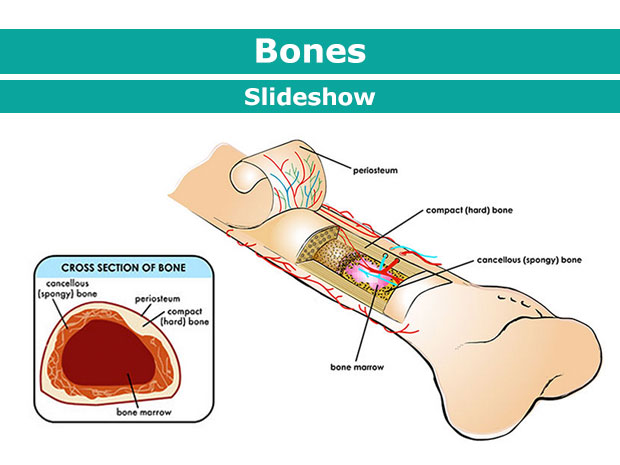
Bones
Our bones give our bodies shape, and support and protect our organs and systems.
Click through this slideshow to learn more about bones.
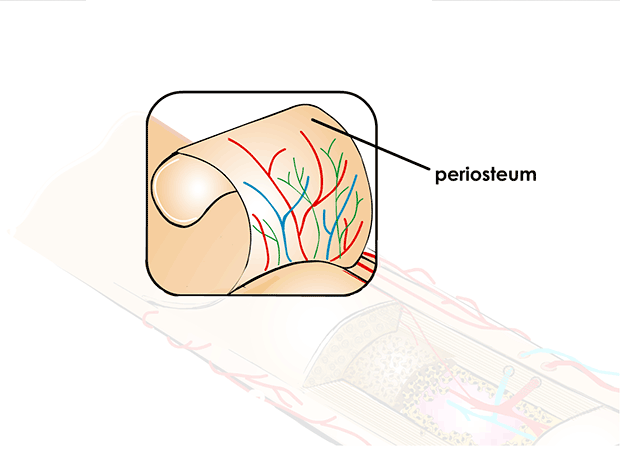
Bones
Periosteum
This thin, dense membrane on the surface of the bone contains nerves and blood vessels that help nourish bone tissue.
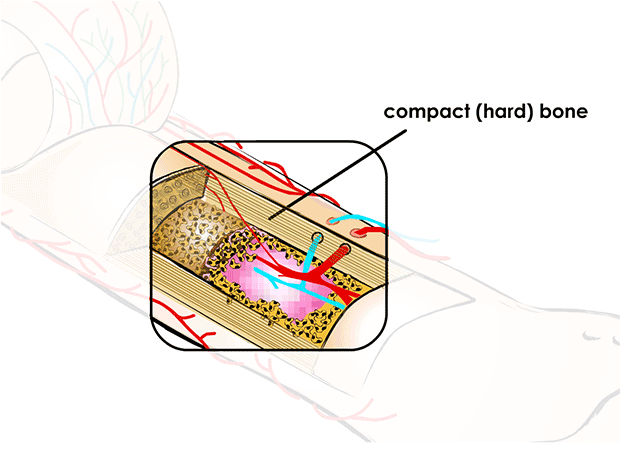
Bones
Compact (Hard) Bone
This type of bone is strong, solid, and whitish in color. It makes up the hard outside portion of a bone.
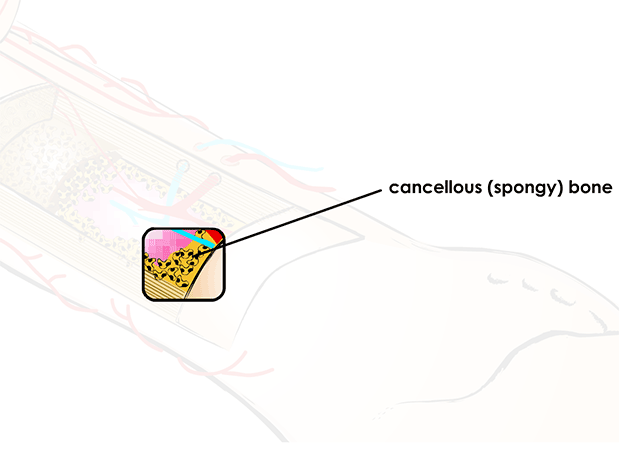
Bones
Cancellous (Spongy) Bone
This type of bone is located inside the compact bone. It looks like a sponge, with bone marrow filling its spaces.
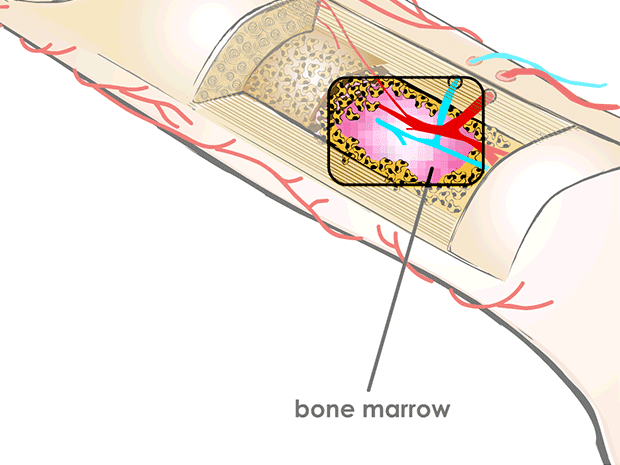
Bones
Bone Marrow
The soft bone marrow, which is found inside many bones, makes most of the body's red blood cells, white blood cells, and platelets.
How Do Bones Grow?
The bones of kids and young teens are smaller than those of adults and contain "growing zones" called growth plates. These plates consist of multiplying cartilage cells that grow in length, and then change into hard, mineralized bone. These growth plates are easy to spot on an X-ray. Because girls mature at an earlier age than boys, their growth plates change into hard bone at an earlier age.
Bone-building continues throughout life, as a body constantly renews and reshapes the bones' living tissue. Bone contains three types of cells:
- osteoblasts (AHS-tee-uh-blastz), which make new bone and help repair damage
- osteocytes (AHS-tee-o-sites), mature bone cells which help continue new born formation
- osteoclasts (AHS-tee-o-klasts), which break down bone and help to sculpt and shape it
What Are Muscles and What Do They Do?
Muscles pull on the joints, allowing us to move. They also help the body do such things as chewing food and then moving it through the digestive system.
Even when we sit perfectly still, muscles throughout the body are constantly moving. Muscles help the heart beat, the chest rise and fall during breathing, and blood vessels regulate the pressure and flow of blood. When we smile and talk, muscles help us communicate, and when we exercise, they help us stay physically fit and healthy.
Humans have three different kinds of muscle:
- Skeletal muscle is attached by cord-like tendons to bone, such as in the legs, arms, and face. Skeletal muscles are called striated (STRY-ay-ted) because they are made up of fibers that have horizontal stripes when viewed under a microscope. These muscles help hold the skeleton together, give the body shape, and help it with everyday movements (known as voluntary muscles because you can control them). They can contract (shorten or tighten) quickly and powerfully, but they tire easily.
- Smooth, or involuntary, muscle is also made of fibers, but this type of muscle looks smooth, not striated. We can't consciously control our smooth muscles; rather, they're controlled by the nervous system automatically (which is why they're also called involuntary). Examples of smooth muscles are the walls of the stomach and intestines, which help break up food and move it through the digestive system. Smooth muscle is also found in the walls of blood vessels, where it squeezes the stream of blood flowing through the vessels to help maintain blood pressure. Smooth muscles take longer to contract than skeletal muscles do, but they can stay contracted for a long time because they don't tire easily.
- Cardiac muscle is found in the heart. The walls of the heart's chambers are composed almost entirely of muscle fibers. Cardiac muscle is also an involuntary type of muscle. Its rhythmic, powerful contractions force blood out of the heart as it beats.
How Do Muscles Work?
The movements that muscles make are coordinated and controlled by the brain and nervous system. The involuntary muscles are controlled by structures deep within the brain and the upper part of the spinal cord called the brain stem. The voluntary muscles are regulated by the parts of the brain known as the cerebral motor cortex and the cerebellum (ser-uh-BEL-um).
When you decide to move, the motor cortex sends an electrical signal through the spinal cord and peripheral nerves to the muscles, making them contract. The motor cortex on the right side of the brain controls the muscles on the left side of the body and vice versa.
The cerebellum coordinates the muscle movements ordered by the motor cortex. Sensors in the muscles and joints send messages back through peripheral nerves to tell the cerebellum and other parts of the brain where and how the arm or leg is moving and what position it's in. This feedback results in smooth, coordinated motion. If you want to lift your arm, your brain sends a message to the muscles in your arm and you move it. When you run, the messages to the brain are more involved, because many muscles have to work in rhythm.
Muscles move body parts by contracting and then relaxing. Muscles can pull bones, but they can't push them back to the original position. So they work in pairs of flexors and extensors. The flexor contracts to bend a limb at a joint. Then, when the movement is completed, the flexor relaxes and the extensor contracts to extend or straighten the limb at the same joint. For example, the biceps muscle, in the front of the upper arm, is a flexor, and the triceps, at the back of the upper arm, is an extensor. When you bend at your elbow, the biceps contracts. Then the biceps relaxes and the triceps contracts to straighten the elbow.
What Are Joints and What Do They Do?
Joints are where two bones meet. They make the skeleton flexible — without them, movement would be impossible.
Joints allow our bodies to move in many ways. Some joints open and close like a hinge (such as knees and elbows), whereas others allow for more complicated movement — a shoulder or hip joint, for example, allows for backward, forward, sideways, and rotating movement.
Joints are classified by their range of movement:
- Immovable, or fibrous, joints don't move. The dome of the skull, for example, is made of bony plates, which move slightly during birth and then fuse together as the skull finishes growing. Between the edges of these plates are links, or joints, of fibrous tissue. Fibrous joints also hold the teeth in the jawbone.
- Partially movable, or cartilaginous (kar-tuh-LAH-juh-nus), joints move a little. They are linked by cartilage, as in the spine. Each of the vertebrae in the spine moves in relation to the one above and below it, and together these movements give the spine its flexibility.
- Freely movable, or synovial (sih-NO-vee-ul), joints move in many directions. The main joints of the body — such as those found at the hip, shoulders, elbows, knees, wrists, and ankles — are freely movable. They are filled with synovial fluid, which acts as a lubricant to help the joints move easily.
Three kinds of freely movable joints play a big part in voluntary movement:
- Hinge joints allow movement in one direction, as seen in the knees and elbows.
- Pivot joints allow a rotating or twisting motion, like that of the head moving from side to side.
- Ball-and-socket joints allow the greatest freedom of movement. The hips and shoulders have this type of joint, in which the round end of a long bone fits into the hollow of another bone.
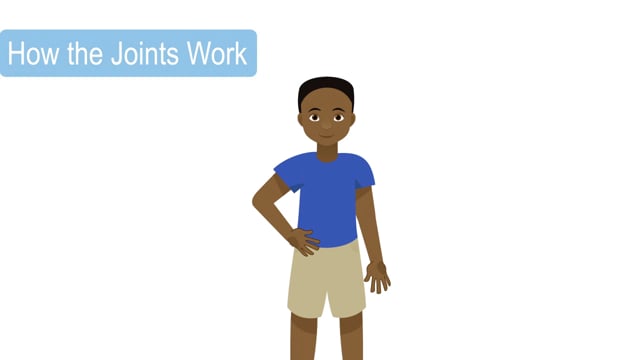
How the Joints Work
- About Body Basics
- Growing Pains
- Buckle Fractures
- Broken Bones
- How to Handle Strains & Sprains
- How to Handle a Broken Bone
- 3 Ways to Build Strong Bones
- Growth Plate Fractures
- How Broken Bones Heal
- Casts

© 1995- The Nemours Foundation. KidsHealth® is a registered trademark of The Nemours Foundation. All rights reserved.
Images sourced by The Nemours Foundation and Getty Images.
Humana Healthy Horizons in Ohio
- Humana Healthy Horizons
- Humana Healthy Horizons Extras
- Member Support
- Care management
- Caregiver resources
- Child well-being
- Disease management
- Documents and forms
- Enrollment
- Grievances and appeals
- Health and wellness
- KidsHealth
- Member Handbook
- New Member Resources
- News and alerts
- OhioRISE Plan
- Pregnancy outcomes
- Tobacco cessation
- Why Humana
- Your primary care provider
- For Providers
- Contact us
- Accessibility
- Humana Healthy Horizons
- Humana Healthy Horizons Extras
- Member Support
- Care management
- Caregiver resources
- Child well-being
- Disease management
- Documents and forms
- Enrollment
- Grievances and appeals
- Health and wellness
- KidsHealth
- Member Handbook
- New Member Resources
- News and alerts
- OhioRISE Plan
- Pregnancy outcomes
- Tobacco cessation
- Why Humana
- Your primary care provider
- For Providers
- Contact us
- Accessibility